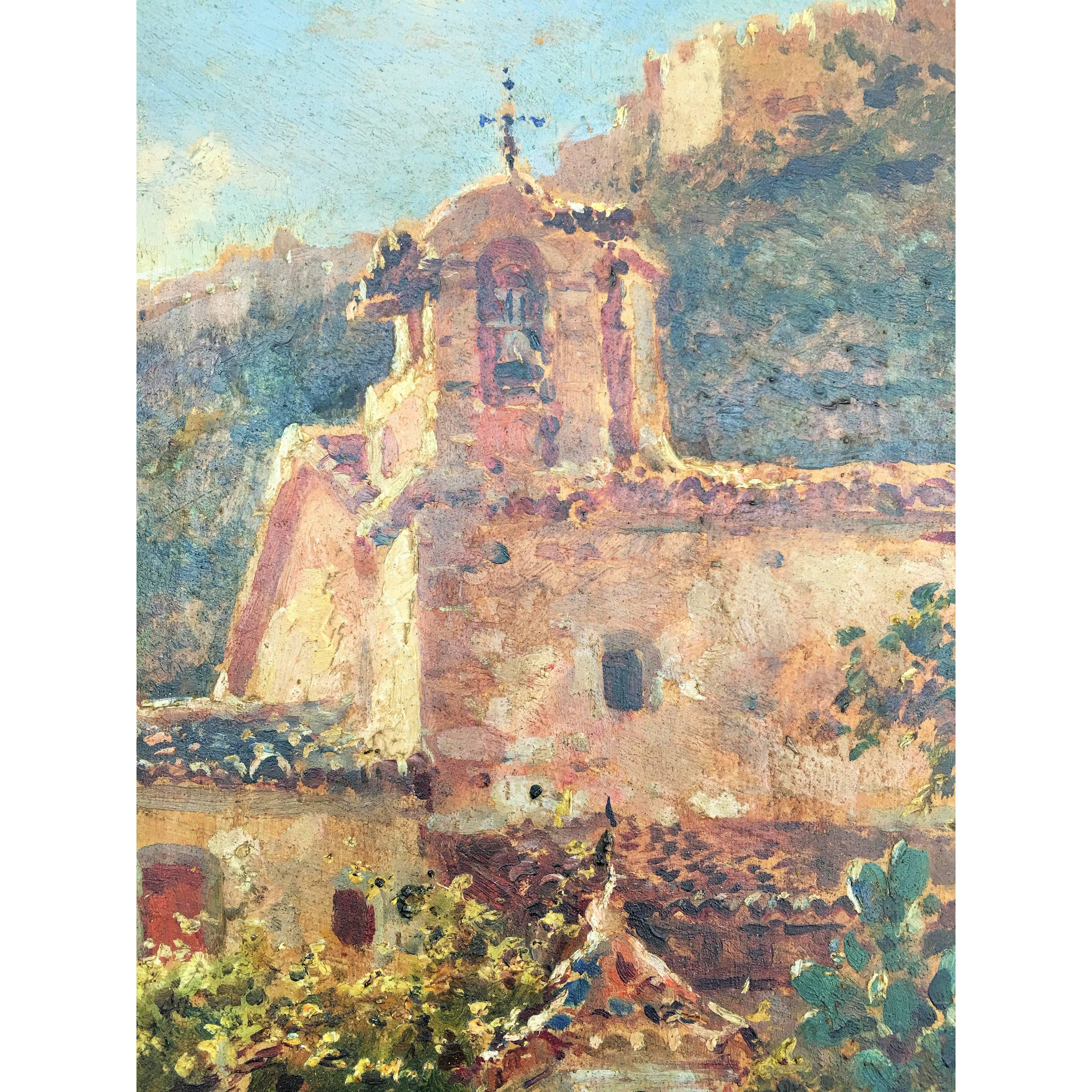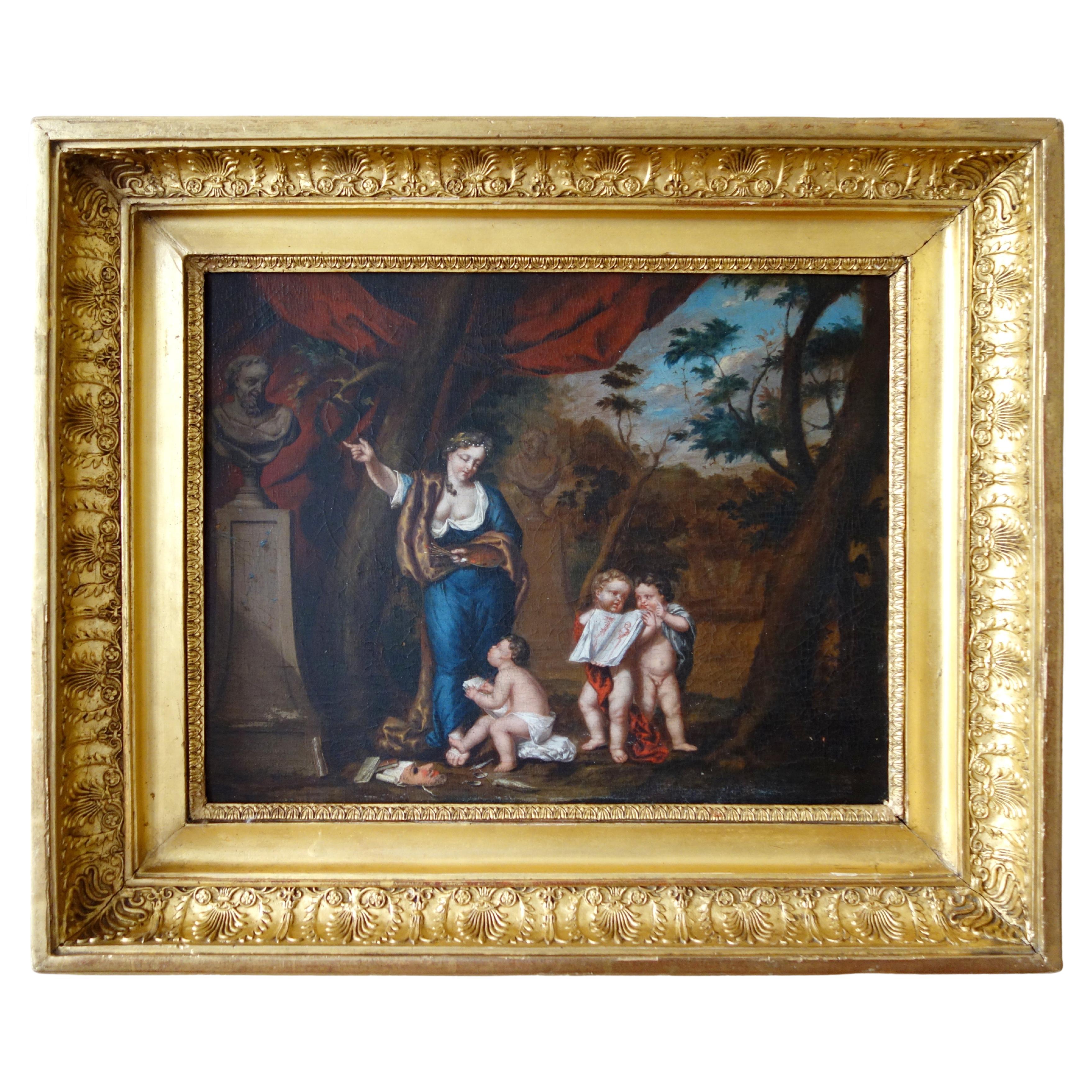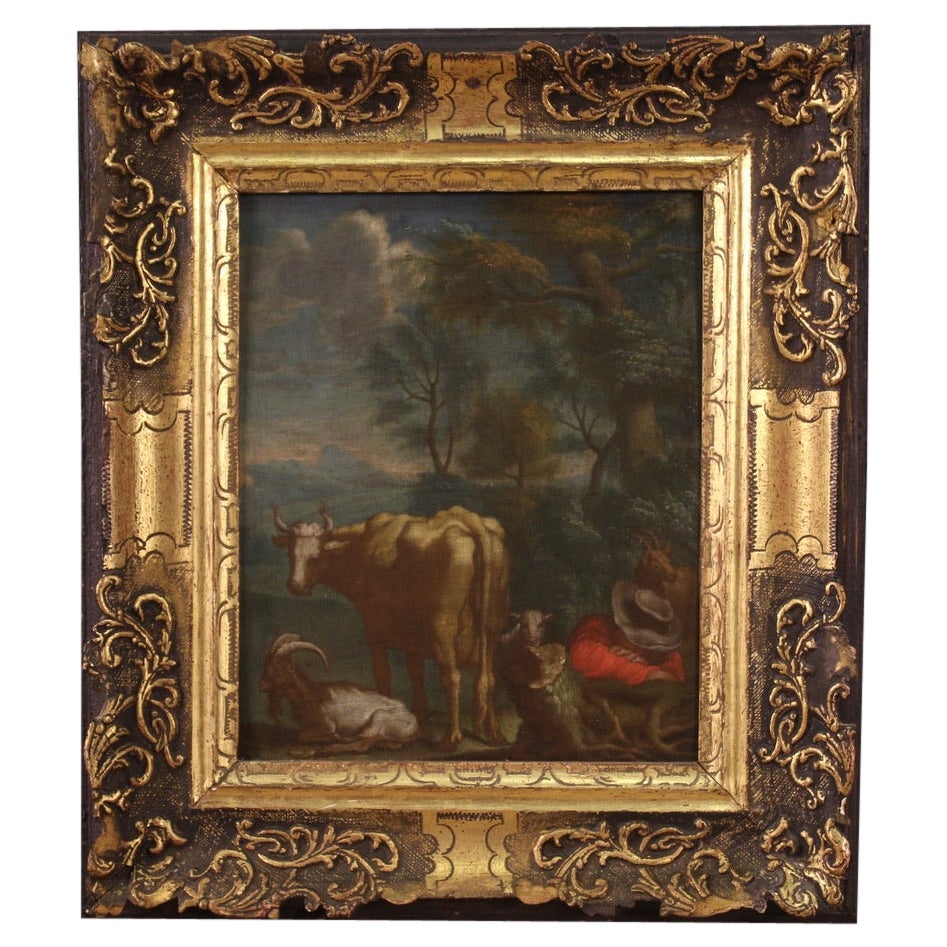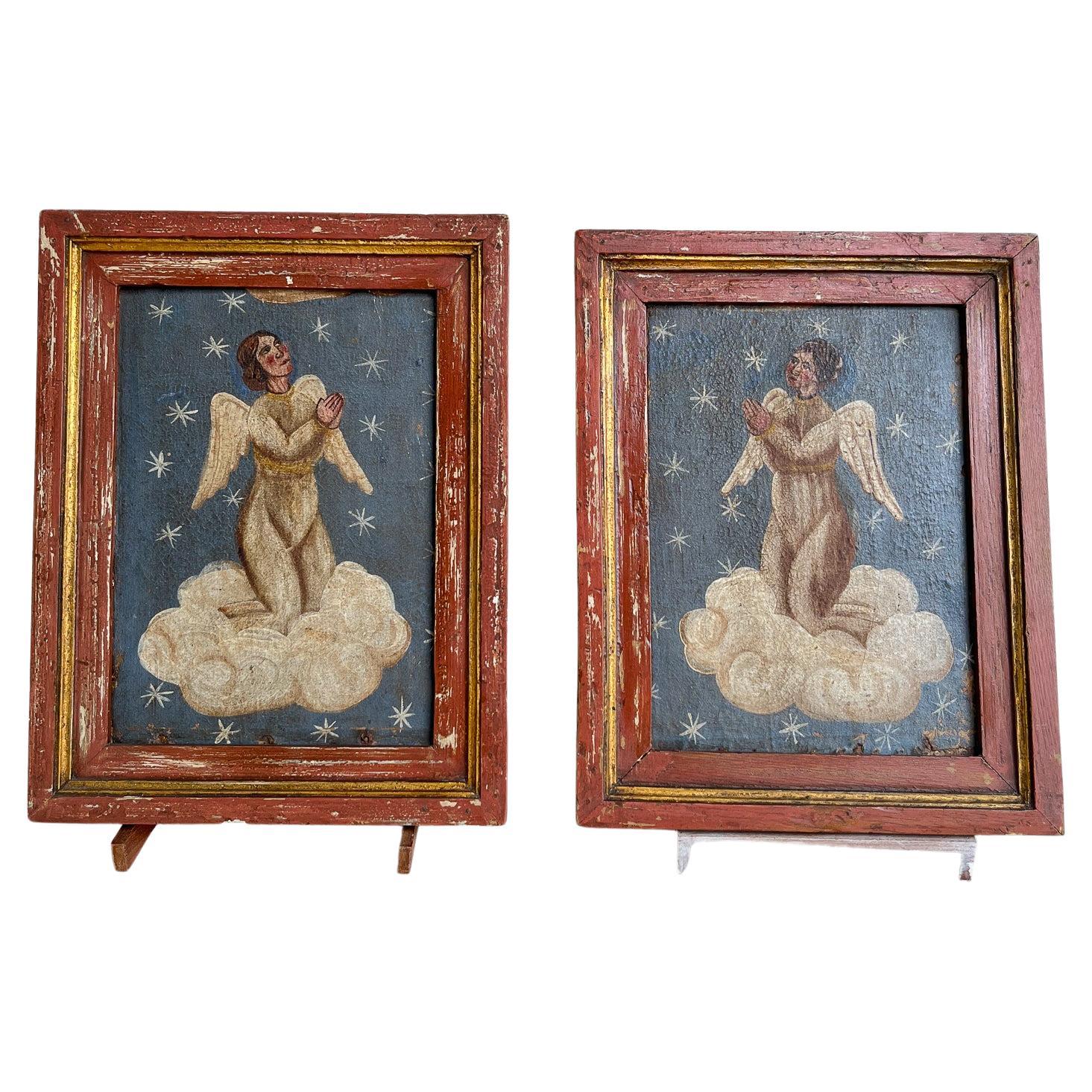Items Similar to 18th Century Transformation of Io into a Heifer Painting Oil on Panel
Want more images or videos?
Request additional images or videos from the seller
1 of 10
18th Century Transformation of Io into a Heifer Painting Oil on Panel
About the Item
Scope of Noël Hallé (Paris, 2 September 1711 - 5 June 1781) Transformation of Io into a heifer
Oil on panel, 49 x 61 cm
Frame 67 x 78 cm
The refined table in question takes up one of the main scenes of the myth of Io and Jupiter, as it has been handed down to us by the Herodotean version. Jupiter, falling in love with Io, daughter of Inaco king of Argos, tries to conquer and seduce her. The god, to hide his infidelity from Juno, envelops the earth with a blanket of clouds. Juno, however, becomes suspicious and orders the mists to dissolve, thus managing to find her consort. Meanwhile, to protect Io from his wife's anger, he transforms the nymph into a white heifer. Juno, sensing the deception, asked for the heifer as a gift and Jupiter could not hold back. Then the goddess entrusted the heifer to Argos with a hundred eyes to watch over her. Jupiter asked Mercury, his messenger, to free her. Mercury, transformed into a shepherd, he put the policeman Argo to sleep by telling him the story of Pan and Syringe, and then beheaded him. Juno, displeased, took Argos one hundred eyes and applied them to the tail of the peacock, an animal sacred to her. I punished again by Juno, who sends her a gadfly to torment her, she is forced to wander relentlessly throughout the earth. Arriving at the arm of the sea between Europe and Asia, she swam across Io, so this took the name of Bosphorus ("passage of the heifer"). Finally the goddess, under the pressure of Jupiter, puts an end to her torture: arrived in Egypt, Io resumes its original appearance. On the banks of the Nile, the girl will give birth to Epapho - progenitor of the lineage of the Egyptians from which the Danaids themselves and finally also Heracles - son of Jupiter and will be venerated by the Egyptian people as goddess Isis. There are two versions of the transformation of Io in Greek mythology, one that seems to date back to Herodotus, the other taken up by Aeschylus in the Supplices. According to the Herodotean version, Zeus himself transforms Io to make Era harmless. Otherwise, in the Supplian version, it was Hera who transformed Io into a heifer out of jealousy and Zeus joined her in the form of a bull. Son of the painter Claude Guy Hallé, Noel received most of his father's teachings and then enrolled in the "Royal Academy of Painting", where he obtained the main prizes and awards, including the award of the Prix de Rome. He was then a guest of the French Academy in Rome, where, later, he was nominated as Director of the École française. Hallé was Jean II Restout's brother-in-law and Jean Jouvenet's nephew; his son was the famous physician Jean Noël Hallé, Napoleon's first physician. Among his pupils was Pierre-Antoine Mongin.
- Dimensions:Height: 26.38 in (67 cm)Width: 30.71 in (78 cm)Depth: 2.37 in (6 cm)
- Materials and Techniques:
- Place of Origin:
- Period:
- Date of Manufacture:18th Century
- Condition:Refinished. Wear consistent with age and use. The painting has been cleaned.
- Seller Location:Milan, IT
- Reference Number:1stDibs: LU5918226764762

About the Seller
5.0
Vetted Seller
These experienced sellers undergo a comprehensive evaluation by our team of in-house experts.
Established in 2000
1stDibs seller since 2021
25 sales on 1stDibs
Typical response time: 10 hours
- ShippingRetrieving quote...Ships From: Milan, Italy
- Return PolicyA return for this item may be initiated within 14 days of delivery.
More From This SellerView All
- 18th Century Portrait of Felice Paganoni Painting Oil on CanvasLocated in Milan, ITAttributed to Giacomo Ceruti (Milan, 1698-1767) Portrait of Felice Paganoni Oil on canvas, 98.5 x 73 cm With frame, 109 x 85 x 4 cm "Felice Pag...Category
Antique 18th Century Italian Paintings
MaterialsCanvas
- 18th Century Cherub Head Sketch Painting Oil on CanvasLocated in Milan, ITVenetian school, 18th century Study with the head of a cherub Measures: Oil on canvas, 45.5 x 41 cm - with frame 54.5 x 49.5 cm The present qualifies as a study or preparatory sketch by virtue of the structural and figural layout; by reason of formal and substantial evidence, it can be traced back to the mature neo-Venetian style, which in the eighteenth century had begun to produce figurations of extreme typological pathetism and formal expressionism. The contemporary painting experience of Tiepolo commanded the Venetian art scene, once the lesson of Pier Francesco Mola (1612-1666) was overruled. The delicate putto head offered here, in which a cherub is recognizable due to the happy iconographic solution of the wings placed under the angel's face, is outlined with a vigorous vitalism. A foreshortened point of view illuminates his face in a grazing way, probing his features with strong shadows and with a youthful blush that orange his cheeks. The veristic perfection with which the artist arranges the semblant is of marvelous expressiveness. The eyes are swollen with intensity, and together with the general setting of the head they denounce a conscious reflection on the physiognomy, peculiar within the emerging context of Venetian painting. The painting in question is affected by the large-scale productions, both monumental and perspective, at the time in vogue in the territory of the Serenissima. Conceived through a vision from below, the portrait reveals from the Venetian Rococo that particular predilection for the open and clear, airy ways, denounced in the first instance by Tiepolo. The conscious detachment from the Cortona-style decorativism and from the repeated layout solutions then in vogue allow us to approach the present to the production of Francesco Fontebasso...Category
Antique 18th Century Italian Rococo Paintings
MaterialsCanvas
- 17th-18th Century View of the Temple of Minerva Painting Oil on CanvasLocated in Milan, ITPainter active in Rome in the 18th-19th century. View of the temple of Minerva Medica Oil on canvas, 65 x 78 cm - with frame 71.5 x 85 cm The painting bears a traditional attribution to François Marius Granet (Aix-en-Provence, 1775 - 1849). The painter was a pupil of David but from 1802 to 1819 he lived in Rome, as evidenced by a series of paintings depicting views of the city and especially of the Roman countryside (Ponte San Rocco in Tivoli, 1810-20, MoMA, New York), and then return there between 1825 and 1830. In the Eternal City Granet devoted himself to landscape painting, inspired by the landscape painting of Gaspard Dughet and Van Lint...Category
Antique Late 17th Century Italian Paintings
MaterialsCanvas
- 18th Century The Sacrifice of Iphigenia Roma School Painting Oil on CanvasLocated in Milan, ITRoman school, 18th century The Sacrifice of Iphigenia Oil on canvas, Measures: 50 x 64.5 cm The canvas depicts The Sacrifice of Iphigenia, a theme reported by numerous sources, including the Greek tragedies Iphigenia in Aulis by Euripides and Agamemnon by Aeschylus, as well as in Ovid's Metamorphoses. The myth tells how the Greeks, under the command of Agamemnon, gathered at the city of Aulis, in Boeotia, from which they then set sail for Troy. The persistent calm of the winds, however, prevents the Greek ships...Category
Antique 18th Century Italian Paintings
MaterialsCanvas
- 17th Century Madonna of the Milk Painting Oil on PanelLocated in Milan, IT17th century Madonna of the milk Oil on panel, 27 x 20 cm - with frame 32.5 x 26 cm The subject of the work in question is particularly fascinating for its sweetness and refinem...Category
Antique 17th Century Italian Paintings
MaterialsWood
- 17th - 18th Century Portrait of Guy Painting Oil on Canvas by Area of AmorosiBy Antonio AmorosiLocated in Milan, ITCircle of Antonio Amorosi (Comunanza, 1660 - Rome, 1738) Portrait of young people Oil on canvas, 87 x 67 cm The painting depicting this portrait was made by an artist activ...Category
Antique Late 17th Century Italian Paintings
MaterialsCanvas
You May Also Like
- 18th Century Sanctuary Oil on PanelLocated in Miami, FL18th century sanctuary oil on panel The Roman Sanctuary of the Felix father in Jativa, Valence, Spain.Category
Antique Late 18th Century Spanish Baroque Paintings
MaterialsWood
- 18th Century Oil on Panel Flemish Painting Portrait of a Lady, 1720Located in Vicoforte, PiedmontAntique Flemish painting from the 18th century. Framework oil on panel depicting a portrait of a noblewoman with a plumed hat of good pictorial quality. 20th century frame in wood an...Category
Antique 1720s Belgian Paintings
MaterialsWood
- Allegory of painting, early 18th century French school - oil on panelLocated in GRENOBLE, FRAntique French school picturing an allegory of Arts : Muse Melpomene (you can tell with her traditional attributes - grapes crown and tragedy mask), wearing antique-style clothes, is...Category
Antique Early 18th Century French Regency Paintings
MaterialsGiltwood, Paint
- European School Oil on Panel of the 18th CenturyBy EuropaLocated in Madrid, ESEuropean School oil on panel of the 18th century Measures: 34X24CM Good condition.Category
Antique 18th Century German Baroque Paintings
MaterialsPaint
- 18th Century Oil On Panel Antique Flemish Landscape Painting, 1750Located in Vicoforte, PiedmontAntique Flemish painting from the 18th century. Framework oil on panel depicting a bucolic landscape with a shepherd, cow and goats of good pictorial quality. Painting of contained s...Category
Antique Mid-18th Century Belgian Paintings
MaterialsPlaster
- 18th Century Oil on Wood Paintings of AngelsLocated in Lisboa, PT18th Century Oil on Wood Paintings of Angels.Category
Antique 18th Century Portuguese Paintings
MaterialsOak
Recently Viewed
View AllMore Ways To Browse
18th French Oil Painting
Mythology Scene Painting
18th Century Girl
Napoleon Oil Painting
Antique Bank Table
Antique Asian End Tables
Greek Watch
Antique Asian Wall Panels
Painted Asian Wall Panels
Egypt King
Egyptian Goddess
Pierre Watch
Antique Table Watch
France And Son End Table
49 Watches
Hand Painted Asian Wall Panels
Peacock Oil
Jupiter Painting





